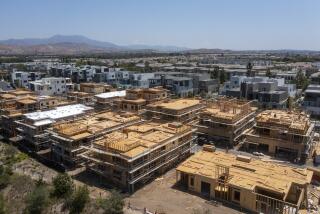New homes in U.S. are growing, survey finds
- Share via
Reporting From Washington — Forget what you’ve heard about the incredible shrinking house. New homes are getting bigger, not smaller. And they will continue to grow, if not up then certainly out.
Why? Because Americans’ hunger for more space appears insatiable, according to a new survey.
The study of people with a proclivity toward buying a new house, conducted by Irvine company John Burns Real Estate Consulting, found that they still want more, not less. And if they can’t get it inside the walls, they’ll take it outside in the form of yard space.
The study is significant for several reasons. First, it covered nearly 10,000 people, a huge sample by any standard.
By comparison, the typical consumer survey by the National Assn. of Home Builders, or NAHB, covers just 2,200 respondents.
Second, respondents to the John Burns study were among 1 million survey recipients who recently registered their email addresses with home builders or land developers, so it is biased toward today’s home shoppers.
More important, though, the findings run counter to what most observers have been saying about houses getting smaller. Builders may be downsizing now, as Census Bureau figures indicate, but other signs — not just the Burns survey — indicate that the trend will reverse itself.
The typical size of a new house peaked four years ago at 2,520 square feet, according to the census, ending a decades-long march toward larger and larger homes. Since then, the average size has fallen back to 2,377 square feet.
But Uncle Sam counts only completed houses. Another survey, this one of housing starts by the NAHB, shows that the average size of houses still under construction was 2,391 square feet at the end of last year.
The bump up is minor, just 14 square feet, hardly the size of a decent walk-in closet. But NAHB economist Rose Quint said her December study was a “much more timely” indicator.
Quint warns against reading too much into the numbers because a second NAHB survey of a core group of builders, also in December, found that most were putting up smaller, less-expensive models.
Furthermore, another broad poll of builders, architects, manufacturers and allied professionals predicted that by 2015, the typical new house would dwindle to 2,150 square feet.
It’s not unusual for houses to slim down during a recession, if only because first-time buyers tend to dominate when the market goes into a tailspin. And this time around, the large number of bargain-priced foreclosures that have flooded the market has hastened the compression.
But after every previous downturn has run its course, square footage has increased. David Crowe, the NAHB’s chief economist, says larger houses could again rule the roost if that’s what the market demands.
“Demographics drive what we build,” Crowe said. “We have to look at who’s coming into the marketplace, and we will cater to what they want.”
What they hunger for, according to the John Burns survey, is more. “Americans’ desire for space is still there,” said Mollie Carmichael, a principal in the firm.
Right now, the market is being driven less out of want and more out of need. In other words, the majority of buyers are people who have to move for one reason or another. Maybe they just got married, or perhaps they have a new baby on the way.
Six or seven years ago, buyers were moving from 2,500-square-foot houses to 3,200-foot manses mostly because they found something better than where they lived. Now buyers are jumping from 1,500-square-foot houses to 2,200-square-foot places out of necessity more than anything else.
“It’s all predicated on life stages,” Carmichael said.
And now that the move-up market is starting to kick in, the consultant thinks those buyers will want more space too. She said a majority of survey respondents “told us that their next home would be bigger than their current home.”
Distributed by United Feature Syndicate.
More to Read
Inside the business of entertainment
The Wide Shot brings you news, analysis and insights on everything from streaming wars to production — and what it all means for the future.
You may occasionally receive promotional content from the Los Angeles Times.










